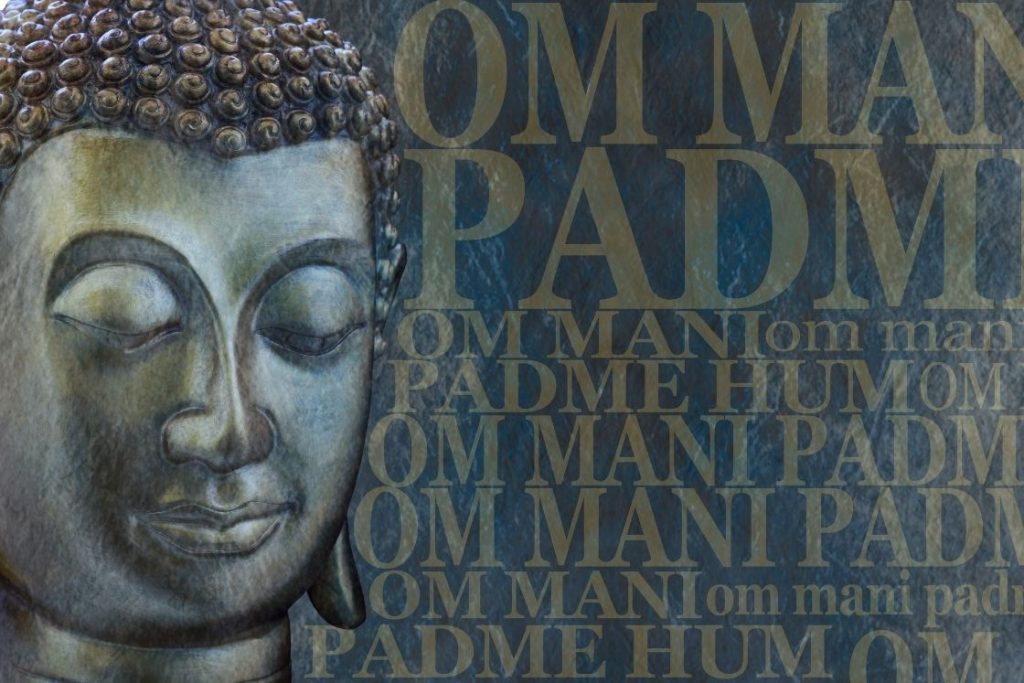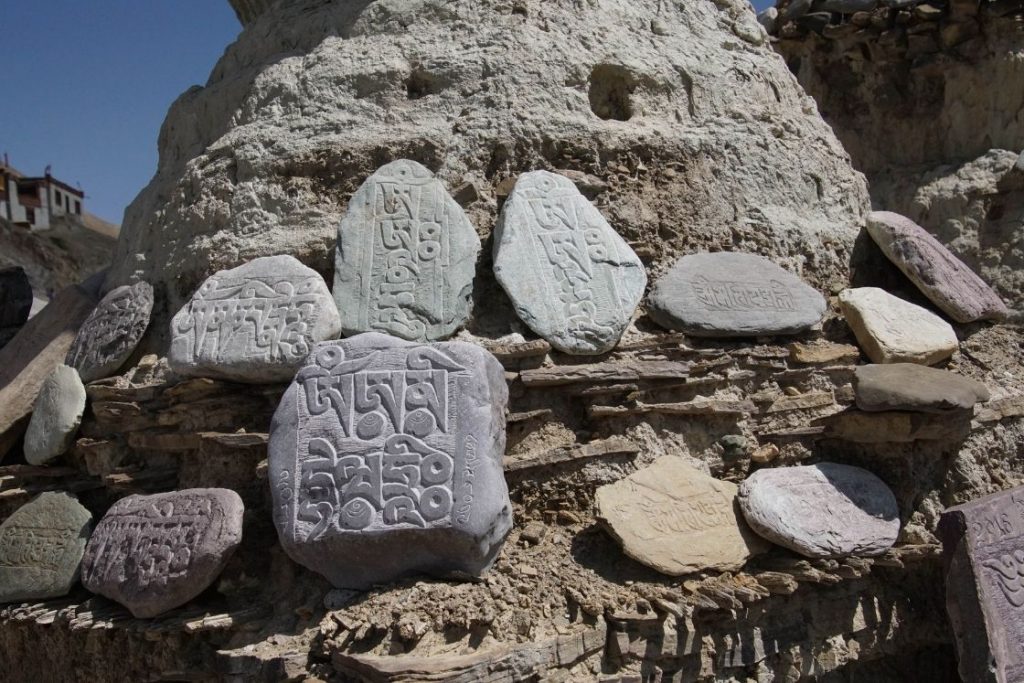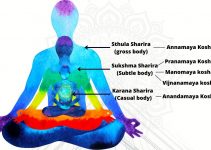
The tradition of chanting has been very popular for centuries in the Eastern world. Mantras in yoga are the combination of meaningful letters or syllables that ignite a sense of divinity within individuals.
Philosophers and yogis from the East believed in the power of correct speech, therefore, they derived the mantras. The same story is true in the case of the well-known Tibetan Buddhist Mantra ‘Om Mani Padme Hum’.
Om Mani Padme Hum mantra has its origin in ancient Buddhist culture. “Kāraṇḍavyūha sūtra“, a 4th century CE Buddhist text is the first scriptural known reference of this mantra. In this text, the mantra is said to induce compassion in a person’s heart which eventually can lead to liberation (moksha) and Buddhahood.
Keep on reading to know the meaning of the mantra, how to practice and the benefits of chanting it.
Mantra Meaning
The Mantra ‘Om Mani Padme Hum’ has a very deep and divine meaning. It’s made up of four Sanskrit words: the initial syllable OM in Buddhism symbolizes the pure exalted body, speech, and mind of a Buddha. MANI symbolizes the illusion (as jewel), PADME symbolizes the light (as lotus), and HUM represents the union of the two.
In English, the mantra is pronounced OHM-MAH-NEE-PAHD-MAY-HUM. It literally translates to “Praise to the Jewel in the Lotus.” However, Tibetan transcription expands upon the mantra’s meaning taking its six syllables; Om, Ma, Ni, Pad, Me, and Hum.
The six syllables of this mantra are associated with six paramitas (perfections) in Buddhism which a person has to invoke to step out of the eccentric mentality. The meaning of each syllable in the mantra:
- Om – represents divine sound; which brings ‘generosity’ in person by purifying the false ego.
- Ma – represents ‘ethics or moral’ to purify the jealousy.
- Ni – represents ‘patience’ one needs to pursue the passion.
- Pad – represents ‘diligence’ to purify ignorance.
- Me – represents ‘renunciation’ to purify greed.
- Hum – represents ‘wisdom’ to purify aggression.
The Meaning of OM
The first word of the Mantra is ‘OM’, also written as ‘AUM’, which denotes the essence of the entire creation. It is believed that the universe was created with the three sounds of A-U-M and the letters reside at the very core of it. The word AUM embraces what was, what is, and what will be in itself.
There is a common belief among Buddhists that the chanting of AUM washes away the pride and egoistic feelings of a person. Also, it represents the practitioner’s impure body, mind, and spirit. By repeatedly chanting OM or AUM, the practitioner essentially throws the three-fold impurity away from his system.
According to Buddhist philosophy, there resides a Buddha in everyone. That’s why a seeker should always try to look for the divinity inwards and not outside. By chanting OM at the beginning of this mantra, the practitioners clear their way to find the Buddha whose body, mind, and soul are crystally pure.
But how can this happen? The answer lies in the next syllables.
The Meaning of MANI
The word Mani literally means a jewel. Just as the jewel is capable of bringing us out of poverty, similarly, articulation of this syllable saves us from mental and spiritual poverty. By repeatedly chanting this, you can move closer to finding the pure mind and spirit.
In this Mantra, Mani represents a selfless desire of a person to reach the Buddha within himself or to attain a stage of enlightenment. An individual’s willingness to find the Buddha is compared to the ability of the jewel- Mani.
When divided into Ma and Ni, Ma represents a dissolvement of jealousy which helps in the purification of mind and soul. Whereas Ni is the syllable that connotes developing patience and tolerance. Together, chanting MANI is associated with the “intention to become enlightened”.
The Meaning of PADME
‘Padme’ literally translates as lotus. The characteristic of the lotus is purity and wisdom. The origin of the lotus is in the mud. But out of its muddy surroundings, the lotus grows to become sterile and pure.
Chanting of ‘PADME’ in this mantra is associated with the seeker’s ability to rise out of the impurity and become unpolluted and clear. Just as the lotus, the mind of the seeker should leave out the pollution, unwanted thoughts from the mind and become pure.
The word is broken into two syllables. ‘Pad’ relates to the dissolvement of prejudices and stereotypes. It clears our judgement and purifies ignorance. Whereas ‘Me’ represents the concentration that dissolves one’s desires and possessiveness.
The Meaning of HUM
The last syllable of the mantra, ‘Hum’ is characterized by the indivisible union of method (is MANI) and wisdom (is PADME). By chanting HUM at the end, we bring all the forces of nature together in a union and that becomes the spirit of enlightenment. It is indivisible, unmovable, and unshakable; Nothing can disrupt this union.
Hum is the one consciousness that combines method and wisdom. It purifies hatred and clears the seeker’s mind towards enlightenment.
Commentary on the Mantra
The six syllables ‘Om Mani Padme Hum’ together mean that through the practice of the path of love, compassion, and wisdom, you can cleanse away all the impurities and purify your body, mind, and soul to find enlightenment just like Buddha.
His Holiness the Dalai Lama comments on the importance of this Mantra that one should contemplate on its meaning while chanting it. The meaning is very deep and vast. He tells the meaning of the Mantra as –
“In dependence on a practice of a path which is an indivisible union of method and wisdom, you can transform your impure body, speech, and mind into the pure exalted body, speech, and mind of a Buddha”.
Chanting these six syllables repeatedly and with the right intention is said to remind the seeker of his ability to purify his mind and speech through method and wisdom and find his own Buddhahood within himself.
Buddhisht Culture
To reveal the Buddhahood within oneself, ‘Om Mani Padme Hum’ is recommended to be chanted daily at the same time meditating upon its meaning “Praise to the Jewel in the Lotus.”
Generally, while chanting this Mantra, a mala (a string of beads) is used. Buddhists chant this mantra during their usual meditation and prayer time. The words are also carved on the big walls of the monasteries and temples.

Also, you can see ‘Om Mani Padme Hum’ written on the prayer flyers or carved onto rocks, known as mani stones, which is a very common and beautiful sight in Tibet. The reason why the sacred words are printed on such flyers is that they move with the wind, spread everywhere in the environment, and the entire universe feels the power of those words.
How to Chant Om Mani Padme Hum?
To let the world feel the power of this chanting, it should be done during your usual meditation or prayer time. It is a consistent practice that one should do before he starts feeling its effects.
If you wish to bring the magic of chanting to your routine, you can chant this Mantra with a focused meditative state for at least 21 times. It is preferred to repeat it 21 or 108 times with a calm and focused mind.
Sit comfortably in a meditative state, focus on your breath, turn your attention inward. With inhaling, begin chanting the words ‘Om Mani Padme Hum’ slowly, by gradually expanding your attention to its script and meaning.
While in meditation, imagine that your chanting is reaching all the living beings in this universe and they are being relieved from all the sufferings. Slowly, after completing 108 rounds (1 cycle of the beads), you can end your meditation with deep breathing.
Benefits of Om Mani Padme Hum Chanting
The benefits of Om Mani Padme Hum lie in chanting it with the pure heart; it ceases all the selfishness and frees you from the attachments. It is the Mantra for the well-being of you and everyone who is a lively part of this universe.
Here are a few benefits of chanting Om Mani Padme Hum that can transform your life in a magical way
- It soothes the senses, promotes uninterrupted flow of the energy in your body, specially in the chakra centres that are needed the most to feel enlightenment.
- On chanting this Mantra, you will feel a clearity in the mind. A clearer mind helps get rid of the ego. And when the ego is removed, a seeker can entirely be focused in the present state.
- Moreover, sound vibrations of this Mantra can help clear the mind which is filled with judgements, pains, tensions, and previous karmas. It helps release all the actions that are holding you from progressing towards enlightenment.
- Om Mani Padme Hum is the Mantra that includes the wish for well-being of all the sentient beings on this planet. Hence, its chanting relieves the sentient beings from their sufferings and helps find their divinity.
- Buddhists believe that chanting this six-syllable Mantra will release one from four defeats of breaking the root vows and five uninterrupted negative karmas.
- The Buddhist Tantras say that when one chants this Mantra, he achieves the four qualities that are required to be born in the sacred land of Buddha.
It is widely believed in Buddhism that chanting Om Mani Padme Hum will make up to seven generations of the person to be born in the upper realm. One person’s consciousness becomes so powerful with this Mantra that it spreads to the next seven generations.
Chanting this Mantra regularly helps an individual live a guilt-free and satisfying life.
Final Thoughts
Om Mani Padme Hum is the simplest Mantra, most commonly chanted by Buddhists all over the world. It is the way to move closer towards the divinity within the person. And once found the Buddhahood within himself, the person can purify everyone who comes in contact.
Chanting is the most healing and noble path that a person could cultivate to live spiritually. Om Mani Padme Hum is the way to do that. It purifies all the judgements, memories, unhealthy feelings, and karmas from the person’s speech and mind. And further, it brings the inner core of the person known to him to meet his own Buddha.





Although I love this mantra I recently saw some unsavoury behaviour on the part of the current dalai lama. What are your thoughts on that please?
Thanks…clear teaching.